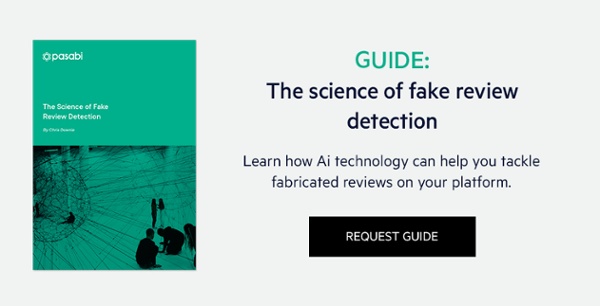“A bad review is like baking a cake with all the best ingredients and having someone sit on it."
Danielle Steele (author)
Amazon is no stranger to bad press. The mammoth marketplace is under constant scrutiny. Between stories of a fractious relationship with its workforce to details of unsafe products being sold on its site by unknown third-party sellers, Amazon is rarely out of the spotlight. Now the tech giant is on the radar for its reviews mechanism - specifically the authenticity of one-star reviews.
According to its own figures, third-party sellers have sold more physical goods on Amazon than the tech giant on its own marketplace, every year since 2015 (BBC News, September 2020). The success of these vendors creates a lucrative revenue stream for Amazon too. In 2019, Amazon generated US$53.76 billion in third-party seller service revenues. Easy to see why it has multiple services available to support these vendors - Fulfilment by Amazon (FBA) and Amazon Handmade to name just two.
Coercive competition
It’s being reported that Amazon’s marketplace is being abused by sellers using one-star reviews as a means to harm competition. Unscrupulous vendors are now realising how hard it is to fake four and five-star reviews to gain a competitive advantage over their hard-working rivals. According to a study carried out by BrightPearl and Trustpilot in June 2019, when making a purchase online, 68% of consumers look at reviews’ star ratings, 61% look at the number of reviews while 44% consider the recency of posts.
Safe to say, reviews impact a brand’s bottom line. If a competitor deliberately attacks your brand by posting negative reviews, it can result in diminished sales and potentially do irreparable damage to your brand.
So, the question is, how can vendors prove the negative reviews are unjust and what does Amazon do about them?
Over to Amazon
According to Amazon’s Customer Reviews policy:
“Customer Reviews should give customers genuine product feedback from fellow shoppers. We have a zero tolerance policy for any review designed to mislead or manipulate customers.”
There are some instances where Amazon will add feedback to reviews. For example, if a customer leaves a negative review for a product regarding its delivery which was solely fulfilled by Amazon and not the seller, Amazon will strike through (put a line through) this feedback and add the following statement:
“This item was fulfilled by Amazon, and we take responsibility for this fulfilment experience.”
The review, in this instance, wouldn’t affect the seller’s star rating. However, there are other occasions where the digital marketplace will remove reviews. They do not, for example, allow multiple negative reviews for the same product from one customer and say they would remove such posts. They also state they don’t permit negative reviews from a seller on a competitor’s product. The difficulty here is that unscrupulous sellers will use clever tactics to undermine rivals’ products. They could post reviews under different usernames, incentivise people to post misleading reviews or they could even resort to using review selling companies to do their dirty work - potentially undetected by Amazon.
In a statement to The Verge (September 2020), a spokesperson for Amazon said the company analyses reviews before they’re made public, processing 10 million submissions weekly.
“We want Amazon customers to shop with confidence knowing that the reviews they read are authentic and relevant. We have clear policies for both reviewers and selling partners that prohibit abuse of our community features, and we suspend, ban, and take legal action against those who violate these policies.”
Prominent consumer rights watchdog, Which?, has called for the online reviews investigation launched in May 2020 by the Competition and Markets Authority (CMA) to include negative review manipulation. Third-party sellers have been interviewed by the BBC who believe they have been affected by such practice.
Under attack
Janson Smith, a UK entrepreneur, had a thriving business selling on the digital marketplace. He started noticing a flurry of one-star reviews. He decided to investigate and cross-referenced the orders with the negative reviews and came to realise almost all of them came from suspicious accounts. He got in touch with Amazon and managed to get them removed.
Another entrepreneur, Ella Keyes, had been successfully selling post-pregnancy products on Amazon. She started seeing one-star reviews appearing. Initially she wasn’t too concerned as the 4 and 5 star reviews offset the overall rating. However, as the volume of negative reviews increased, her sales dropped off. Sadly after a few months, the stress of it became too much and she decided to abandon her venture.
The issue of fictitious one-star reviews is equally important for Amazon as fake five-star reviews. This type of review manipulation has a damaging effect on brands and consumers alike in a digital marketplace where trust and authenticity are paramount.
FBI involvement
There’s mounting pressure for Amazon to take action to clamp down on fake one-star reviews. In September 2020, six people in Seattle were indicted by a Grand Jury in Washington for conspiring to pay over US$100,000 in commercial bribes to Amazon employees and contractors, in exchange for an unfair competitive advantage worth more than US$100 million on Amazon Marketplace.
U.S. Attorney Brian T. Moran said:
“As the world moves increasingly to online commerce, we must ensure that the marketplace is not corrupted with unfair advantages obtained by bribes and kick‑backs. The ultimate victim from this criminal conduct is the buying public who get inferior or even dangerous goods that should have been removed from the marketplace.”
Special Agent FBI Seattle, Raymond Duda, commented on the defendants’ actions:
“Realising they could not compete on a level playing field, the subjects turned to bribery and fraud in order to gain the upper hand. What's equally concerning, not only did they attempt to increase sales of their own products, but sought to damage and discredit their competitors. This indictment should send a message that the FBI will not sit on the sidelines while criminals try to cheat their way to the top.”
In the course of the conspiracy going back as far as 2017, the defendants acted as ‘consultants’ to third-party sellers. Three of them also operated as vendors on the marketplace. They paid bribes to Amazon employees to:
- Facilitate attacks against competitors
- Reinstate suspended merchant accounts and product listings
- Provide unauthorised confidential information regarding operating procedures and algorithms
- Bypass Amazon’s internal limits on third-party accounts
The corrupted employees facilitated attacks against competitors’ accounts and listings. They used their inside access to Amazon’s network to share competitive intelligence and suspend rivals’ accounts. They gave the ‘consultants’ information about Amazon’s internal algorithms allowing them to flood their rivals’ product listings with fictitious negative reviews.
The consequences for these offences carry hefty fines and lengthy prison sentences. The FBI’s involvement is a positive step that such behaviours will not be tolerated and should act as a deterrent to others considering similar fraudulent activity.
However, activity on a smaller scale is unlikely to attract the attention of the FBI. Fictitious one-star reviews have been a problem on the tech giant’s site for years. An article in the New Statesman as far back as 2014 highlighted how authors were being hit by fake negative reviews.
What can brands do?
So what can brands do to protect themselves? It comes down to monitoring and reacting. Until Amazon cracks down on effectively policing and removing fake reviews on a large scale, brands need to look out for themselves. Whether you’re a small-sized retailer using Amazon to reach a wider audience, or a larger brand selling multiple product lines, monitoring your reviews is key to detecting foul play. Address and log the negative reviews when they’re posted. This way you can potentially spot fraudulent activity, circumvent future consumers’ concerns and ultimately get Amazon involved. It’s time for the digital marketplace to step up its efforts.


